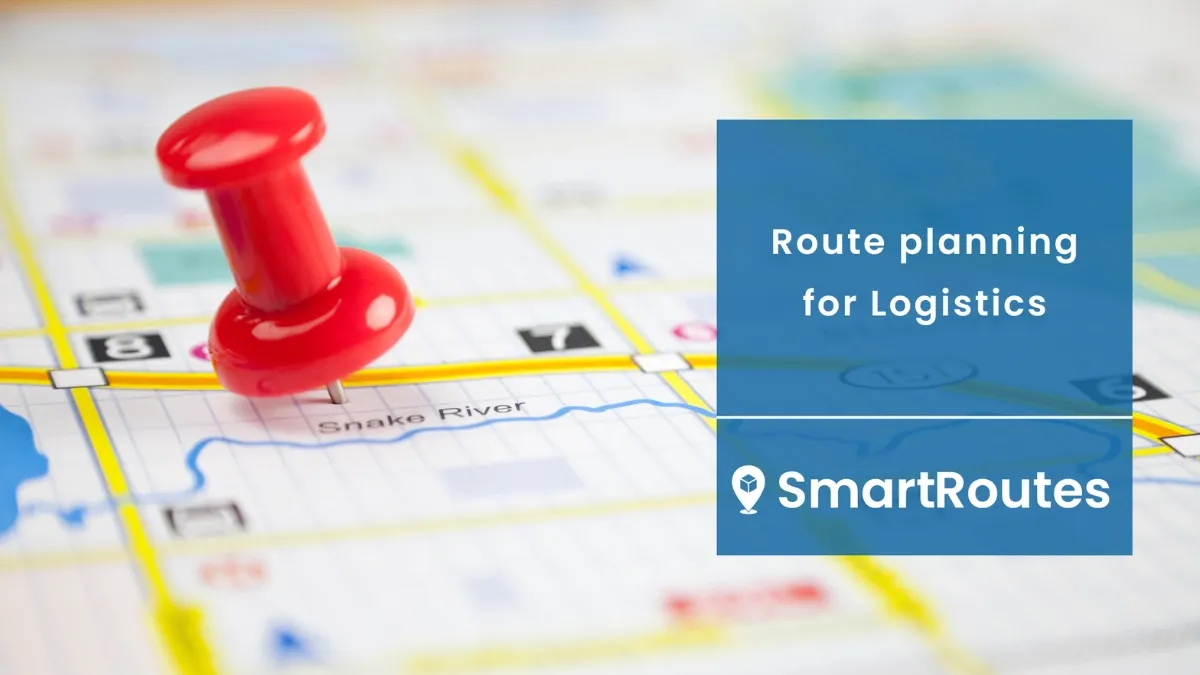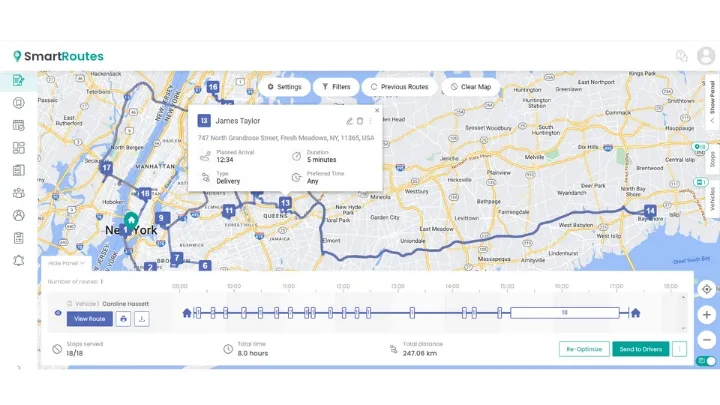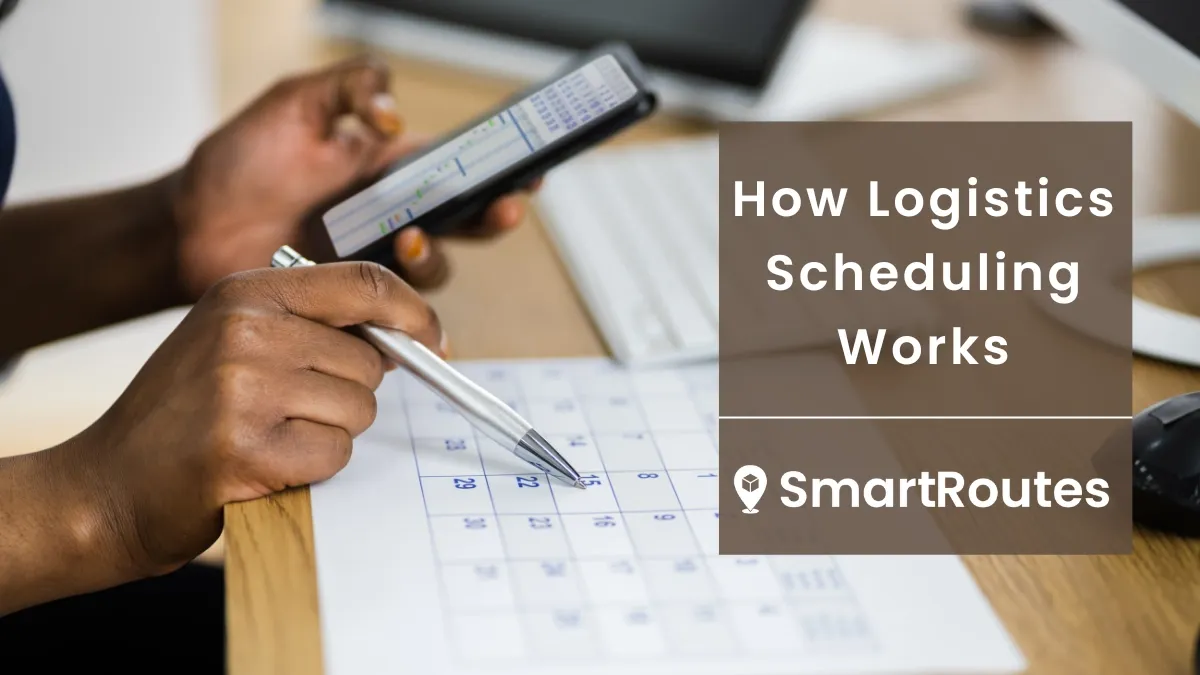Route Planning for Logistics
Logistics teams require route planning and optimization tools to ensure efficient delivery rates and to reduce costs. Learn how to implement it here.

Logistics firms involved in last-mile delivery are both going through a boom time but are also under more pressure than ever before. A rise in online consumerism and home-delivery services has increased customer service demands to new heights for last-mile deliveries, with more than 38% of consumers preferring to only wait one day or less for delivery. Matched with this are rising fleet and labour costs, increased traffic congestion, and market competition. For logistics firms route planning is more complex than ever before and the ability to make money is dependent on being highly efficient.
At SmartRoutes, we have leveraged innovative technology to keep you ahead of the game and ensure your Logistics & 3PL services meet the highest standards.
Why is Route Planning in Logistics Important?
Route planning in logistics is essential to ensure efficiency and productivity at every step of the delivery process. From accommodating customer delivery requirements, vehicle constraints, to providing a good delivery experience and so on. With the last mile accounting for approximately 50% of delivery expenses, it's important for businesses to invest in tools like route planner. Efficient routing will reduce fuel costs, increase driver drop rate and so on thus improving the overall profitability of the business.
It can be intimidating to move away from a purely based process however the efficiencies it brings makes it a no-brainer. It reduces the risk of manual route planning by pulling order information from your ERP system or uploaded spreadsheet and automatically plans the route, optimizes it based on set requirements and assigns routes to your drivers.
SmartRoutes Route Planning for Logistics Solution
Save time and money in delivery management. Cut carbon emissions. Get oversight on your fleet. Impress your customers with superb communication tools.

The Benefits of Route Planning for Logistics
Time and Cost Savings
Route planning and route optimization enables logistics companies to optimize the delivery routes, resulting in significant time and cost savings. By determining the most efficient routes, companies can minimize the distance traveled, reduce fuel consumption, and lower maintenance costs for vehicles. Route optimization software also enables companies to complete more deliveries in less time, which translates to increased productivity and lower operation costs.
Improved Customer Service
Effective route planning can improve customer service by providing accurate and reliable delivery schedules. Customers appreciate receiving their deliveries on time, and logistics companies that can provide accurate ETAs can increase customer loyalty and satisfaction. Furthermore, route planning can help companies identify potential delivery delays in advance and communicate them to customers proactively.
Increased Operational Efficiency
Route planning can improve the operational efficiency of logistics companies by reducing idle time and ensuring that vehicles are fully utilized. By optimizing routes, companies can eliminate unnecessary stops and ensure that all vehicles are assigned the optimal number of deliveries. This optimization also reduces the likelihood of missed deliveries or incorrect orders by utilizing delivery windows, resulting in fewer re-deliveries and better operational efficiency.
Enhanced Safety
Route planning can enhance the safety of logistics operations by identifying potential hazards and avoiding them. Route planners can take into account factors such as traffic congestion, road closures, and weather conditions to determine the safest and most efficient route. This optimization reduces the likelihood of accidents and ensures that drivers can complete their deliveries safely and efficiently.
Better Environmental Performance
Effective route planning can also improve the environmental performance of logistics companies. By optimizing delivery routes, companies can reduce fuel consumption, emissions, and carbon footprint. This optimization aligns with sustainability goals and can help logistics companies demonstrate their commitment to environmental responsibility

How can Route Planning Software Improve Logistics Operations?
SmartRoutes provides a single platform to track and manage the entire delivery operation in real-time. To ensure you get the most out of logistics route planning software make sure you look for the following:
Delivery Driver app
A delivery driver app is a critical component of route planning software. It allows drivers to receive their assigned routes automatically and provides clarity on their working hours for the day. Additionally, the app should give dispatch notes to drivers by individual stop/customer so that they know precisely what to do at each location. The app should also enable drivers to navigate their route effectively and on-time, take driver notes for end-of-day reports without having to talk to dispatch managers directly, and record signatures, notes, and proof-of-delivery.

Live Package Tracking Portal
A live package tracking portal is an essential feature of route planning software that enhances the customer experience. It provides customers with real-time updates on the delivery status of their packages and improves transparency and communication between logistics companies and their customers. Providing a live package tracking portal to customers can improve the delivery experience.
Data Cleansing & Address Verification
Data cleansing and address verification are crucial elements in logistics route planning software. Route planning software should automate the cleaning and updating of inaccurate addresses. This feature ensures that the address data used in route planning is accurate, up-to-date, and reliable. By eliminating incorrect addresses, logistics companies can reduce delivery errors, save time, and improve customer satisfaction.
Route planning software should also automatically verify the authenticity and location accuracy of addresses provided by customers. This feature ensures that the addresses used in route planning are legitimate and located where they are supposed to be. By verifying address authenticity and accuracy, logistics companies can prevent failed deliveries, minimize re-routing, and optimize their delivery operations.
Reporting and insights
SmartRoutes offers powerful reporting and insights features to help logistics companies become data-driven and improve their delivery operations. Logistics companies can generate end-of-day/week reports on driving time, efficiency, and route diversions. These reports provide valuable insights into the performance of the delivery operation, enabling companies to identify areas for improvement and make data-driven decisions. Routing software should automate weekly or monthly reports on key metrics such as DOT, CSAT, NPS, etc. This feature saves time and ensures that reports are always up-to-date, enabling logistics companies to track performance over time and identify trends.
By using SmartRoutes, logistics companies can become data-driven and generate insights to improve the experience for drivers and customers. Route planning software provides valuable data on delivery operations, enabling companies to identify areas for improvement, optimize routes, and improve customer satisfaction. Route planning software can also help companies become less reliant on driver local knowledge of routes and individual stops. With driver notes reports and historic route data, logistics companies can build a comprehensive understanding of their delivery operations and ensure that drivers have all the information they need to complete their routes efficiently.

Integrations
Integrations are an essential feature of logistics route planning software, and SmartRoutes offers seamless integration with third-party software providers. With SmartRoutes, logistics companies can integrate their current Telematics and Order Management Systems, allowing them to streamline their operations and maximize efficiency. SmartRoutes has a proven track record of working with a wide range of third-party software providers, ensuring a smooth integration process (See integrations list here).
Looking for Route Planning Software for Logistics?
If you're looking to implement route planning software for your logistics operations then look no further than SmartRoutes. You can try it out with our 7-day free trial or book a demo today. We can get you up and running in minutes and help you to make the most of it from the outset.
Frequently asked questions
1. How does route planning software improve logistics operations?
Route planning software improves logistics operations in several ways:
- Cost Reduction: By minimizing distances traveled and optimizing routes, fuel costs decrease, vehicle wear-and-tear reduces, and overall operational expenses lessen.
- Time Efficiency: Optimized routes ensure quicker deliveries, meeting tight schedules and customer demands promptly.
- Enhanced Accuracy: Real-time updates and data integration provide accurate information, reducing errors and improving overall delivery precision.
- Resource Optimization: Efficient route planning allows for better utilization of available resources, from vehicles to manpower, leading to increased productivity.
2. What challenges can arise in logistics route planning, and how can they be overcome?
Challenges in logistics route planning include:
- Dynamic Conditions: Changes in traffic, road closures, or unforeseen delays can disrupt planned routes.
- Variable Constraints: Vehicle capacities, delivery time windows, and specific route limitations pose challenges.
- Data Accuracy: Inaccurate or outdated data may lead to suboptimal route planning.
- Real-time Updates: Utilize software that integrates real-time traffic and weather data to dynamically adjust routes.
- Flexible Planning: Implement contingency plans and route alternatives to accommodate unexpected changes.
- Data Management: Regularly update and verify data sources to ensure accuracy in route planning.
3. How can I plan dynamic routes?
Planning dynamic routes involves adapting to real-time changes efficiently:
- Real-time Data Integration: Use software that integrates live traffic updates, weather forecasts, and other dynamic data sources.
- Algorithmic Adaptability: Employ route planning algorithms that quickly recalculate routes based on changing conditions.
- Flexible Scheduling: Allow adjustments in delivery schedules and routes to accommodate unforeseen events or changes.
If you enjoyed this blog, you might also be interested in:









